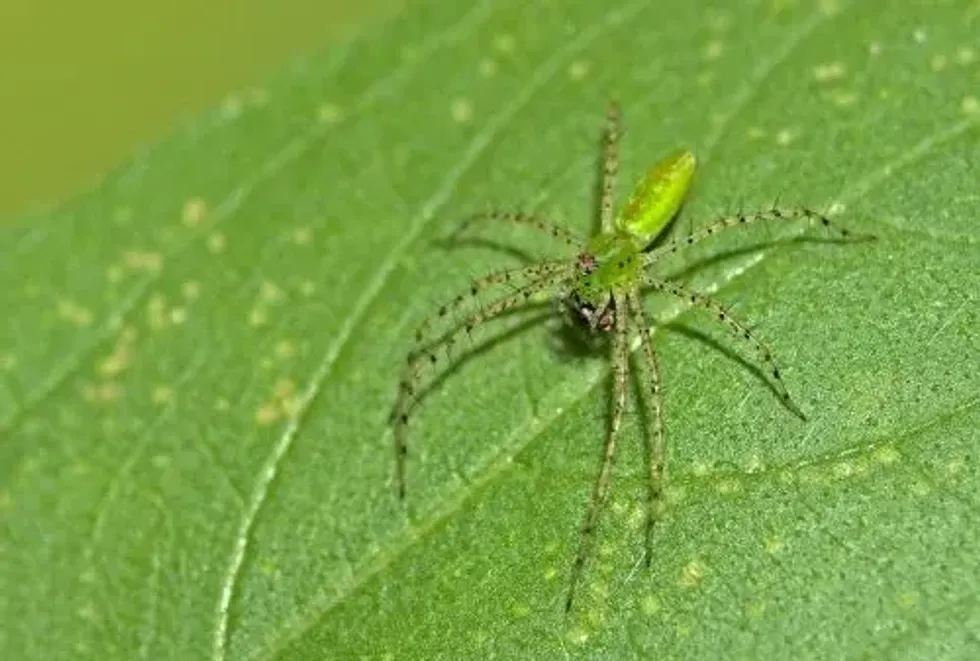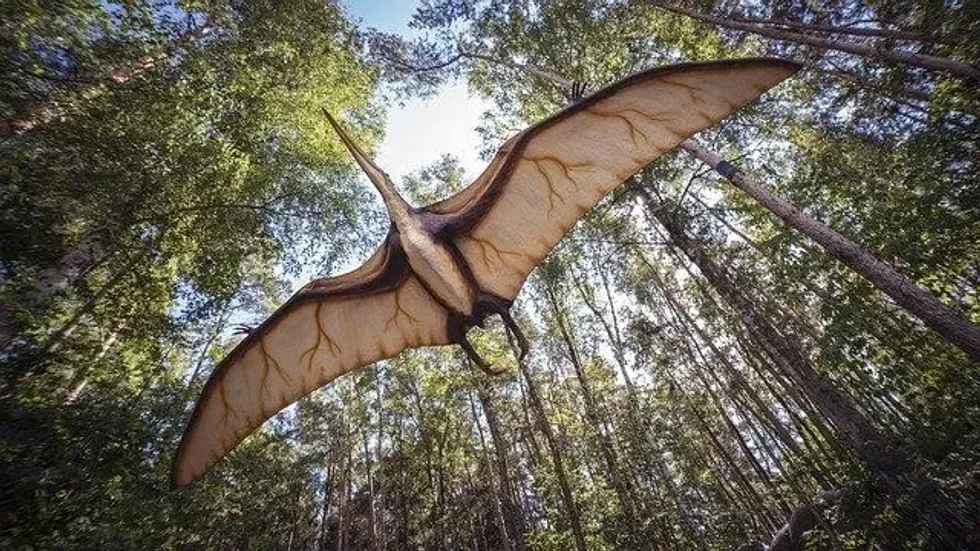The green lynx spider is a minuscule webless predator that lies in wait for its victim in low shrubs and vegetation. Once locked onto a target, these sneaky spiders speed up and pounce high upon their unsuspecting prey.
They can be incredibly fast in the process and also possess an additional weapon: their venom.
These green lynx spiders can spit venom to distances of up to 8 in (20.32 cm), immediately disabling their prey before consuming them.
Green lynx spiders prey upon moths, insects, honeybees, and larvae and the green lynx spider can see their prey up to 4 in (10.16 cm) away. They, like other oxyopidae, are diurnal hunting spiders and their keen eyesight can be compared to that of wold and fshing spiders.
The green lynx spider (Peucetia viridans) is a conspicuous, small, bright green spider found living in woodlands and grasslands. A green lynx spider could be spotted living in low shrubs and plants and in tall grasses, woods, and wildflower meadows. These spiders are commonly spotted in Florida, Mexico, Central America, and the West Indies.
They are a crucial predator to some invasive crop pests, including cotton leafworm moths, cabbage looper moths, and corn earworm moths. Green lynx spiders play a crucial part in the protection of crops by eating these very pests and insects.
That being said, these spiders are also known to consume bugs that are otherwise beneficial to crops and land. These insects are usually called beneficial insects.
A green lynx spider (Peucetia viridans) is said to have one generation a year, the female guards produce an egg sac or two comprising roughly 600 eggs. The female lynx spider lays about 25-400 bright orange eggs.
She often builds a protective layer of leaves and silk to guard her egg sac against different predators. Female spiders prefer to protect their eggs by sitting on top of the egg sac with their legs crossed and wrapped around the sac.
Let's have a look at these intriguing green lynx spider facts. If you like these, do also read our yellow sac spider and hobo spider facts.
Green Lynx Spider Interesting Facts
What type of animal is a green lynx spider?
A green lynx spider (Peucetia viridans) is a species of spider found in areas of North America. They are a species that is known to spit venom and prefer living in low-lying shrub-like vegetation, eating pests as well as beneficial insects.
The eyesight of a green lynx spider is not as good as that of jumping spiders, limiting their vision to 4 in (10.16 cm).
What class of animal does a green lynx spider belong to?
The green lynx spider belongs to the Arachnida class. They are bright green and are often seen preying on crop pests.
How many green lynx spiders are there in the world?
It is tough to estimate the population of these spiders in the world. However, according to a few statistics, two species of the genus Peucetia can be found in abundance worldwide, namely Peucetia viridans and Peucetia longipalpis.
Peucetia viridans can be spotted in Florida, Mexico, Central and North America, and the West Indies. While the genus Peucetia longipalpis can be found in most southwestern United States, south to British Honduras.
Where does a green lynx spider live?
The green lynx spider (P. viridans) prefers living in grasslands and woodlands. They can also be spotted in low shrubs, plants, tall grasses, and meadows of wildflowers. The green lynx spider's country of habitat varies across the regions of Central and North America, Mexico, and the West Indies.
What is a green lynx spider's habitat?
The prime habitat of a green lynx spider (Peucetia viridans) is low shrubbery, herbaceous plants, tall grass, and wildflower meadows. They are also often seen on clumps of prickly pear cactus. Apart from that, green lynx spiders are spotted in areas such as woodlands and grasslands of the various regions of North America.
Who do green lynx spiders live with?
Green lynx spiders generally prefer living with species of their own kind. However, they do also co-exist with certain tiny bugs. They can also be spotted with other species of spiders across North America.
How long does a green lynx spider live?
Green lynx spiders have a lifespan of about one year. However, they tend to live longer in captivity.
How do they reproduce?
A green lynx spider (P. viridans) tends to have only one generation in a year. The female green lynx spider lays her egg in an egg sac which she hangs from her web.
She lays anywhere between 25 to 400 bright orange eggs in the months of September and October and guards them tirelessly. This spider builds a protective layer of leaves and silk to protect her egg sacs against different predators.
The egg sac, when first created, is light green but changes color in due time to a straw color.
She then hangs herself to this egg sac and guards the eggs as well as the young ones once they are born. Once the female attaches the colorful egg sac to a plant, she either prefers to sit on top of the egg sacs with her legs wrapped around it or just hangs upside down from the sac.
What is their conservation status?
According to the IUCN, the conservation status of green lynx spiders is declared to be Least Concern.
Although it is difficult to get a worldwide estimate on these spiders, there are two species of spiders belonging to the Peucetia genus on record.
While the Peucetia viridans exist in the southern United States, Mexico, Florida, and the West Indies, the second species of this genus Peucetia, Peucetia longipalpis, is known to exist in parts of the southwestern United States and south of British Honduras.
Green lynx spiders prefer living in the low shrubs, tall grasses, and meadows of wildflowers and it is in these locations where the species is able to thrive.
Green Lynx Spider Fun Facts
What do green lynx spiders look like?
A green lynx spider is bright green with long thin legs that are pale green or yellow in color. They tend to have numerous black spots all over their body (the region around their eyes tends to have red dots as well) accompanied by elongated black spines.
These spiders have an exoskeleton structure. The size of a green lynx spider is 0.47-0.86 inches (12-22 mm) long and 16 mm (0.62 inches) tall. The female lynx spider is larger than the male.
How cute are they?
This is subjective and whether a green lynx spider is cute or not varies from person to person. Generally, spiders are considered a bit creepy, rather than cute. Enthusiasts beg to differ and stand by the fact that different spiders are different levels of cute. As tiny as it is, the green lynx spider is somewhat cute!
How do they communicate?
A green lynx spider communicates using different vibrations known as seismic vibrations. Green lynx spiders use these at times of courting, to warn rivals, or while attempting to catch prey.
A few of these spiders also tend to mimic the vibrations of insects that could be their potential prey in order to set up a trap for other spiders, clever right?
How big is a green lynx spider?
A green lynx spider is approximately 0.47-0.86 in (12-22 mm) in length. It is roughly five times bigger than the common housefly.
How fast can green lynx spiders move?
The speed of a green lynx spider hasn't been measured yet, although they're said to be very fast runners known for jumping on their prey.
How much does a green lynx spider weigh?
The weight of a green lynx spider (Peucetia viridans) is approximately 2.2-22 lb (1-10 mg).
What are their male and female names of the species?
Neither male nor female names exist for these spiders.
What would you call a baby green lynx spider?
A baby green lynx spider, like most other spiders, is called a spiderling or a nymph. Green lynx spider nymphs are quite similar in their shape when compared to adults, but are more brownish in color, and have dark accents around their body and a light orange abdomen.
What do they eat?
Green lynx spiders are seen feeding on insects and crop pests, hence playing an important role in protecting crops from major destruction. These green lynx spiders also prey on moths, honeybees, and insect larvae. These spiders are known to be fast runners and also venom shooters, which helps them to catch their prey.
Are they harmful?
The venom of these spiders released with their bite may lead to minor swelling and redness and, at times, pink eye. The bite can look quite swollen, often growing to up to 10 in (25.4 cm) in diameter.
Would they make a good pet?
Keeping in mind their required favorable environment, it is fair to say that they are not a simple pet to keep. It is difficult to provide them the atmosphere that they need to live in.
Did you know...
The green lynx spider is a webless ambush spider. This means that it is a spider that does not spin its own webs and directly preys on its victims via a sudden ambush. The green lynx spider is considered one of the few spider species to spit venom on their prey.
The green lynx spider is known for changing its body color to camouflage with its surroundings, especially when locating and approaching prey.
The eyesight of a green lynx spider is not as good as the jumping spider's, and it can see its prey only up to a distance of 4 in (10.16 cm).
Green lynx spiders, like the oxyopidae, are diurnal hunting spiders, which means they become hunters during the day. They don't need to eat very often, often eating just once a week.
Green lynx spiders move around by jumping, but they are not officially classed as a jumping spider!
Green lynx spider bites
Is a green lynx spider poisonous? Yes indeed, but not as much as you might think. A green lynx spider bite is indeed a little painful and may further lead to swelling, redness, and in some cases, pink eye.
How to tell if a green lynx spider is male or female
The easiest way to tell the gender of this spider comes from the fact that the male green lynx spider is much smaller in comparison to a female. They also have significant differences in color and body patterns.
Here at Kidadl, we have carefully created lots of interesting family-friendly animal facts for everyone to discover! Learn more about some other arthropods including the six-eyed sand spider, or the orb-weaver spider.
You can even occupy yourself at home by drawing one of our Green lynx spider coloring pages.










